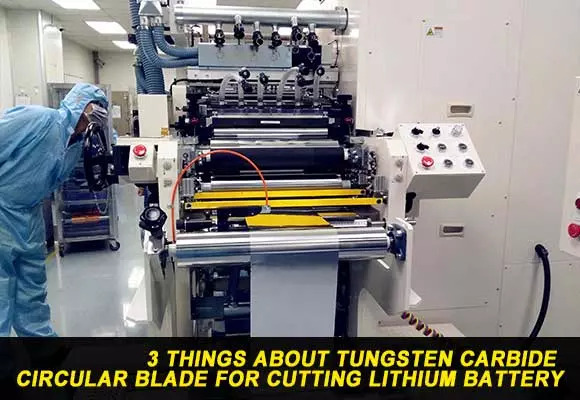
3 Things About Tungsten Carbide Circular Blade For Cutting Lithium Battery
Konetool manufactures and supplies carbide lithium battery cutting blades for the lithium battery industry. They have a good metallographic structure and high processing accuracy. Excellent material selection and professional edge grinding technology achieve advantages of flat and sharp edges. Resistance is small. Wear resistance is high. The blade is sharp and durable. Its life is more than 5 times that of high-speed steel, which effectively improves production efficiency and has an unparalleled cost performance.

Cutting method of Tungsten carbide lithium battery blades

There are two kinds of electrode slice-making methods for lithium-ion power batteries, which are blade cutting and laser cutting. The edge burr of the electrode piece is large. The coating area is easy to be damaged. The quality of electrode pieces is difficult to guarantee and the qualified rate is low. Nowadays, laser cutting technology has been widely used. Since laser cutting is easy to cut any size and shape through program control, the edge of the electrode piece is free of burr and damage, and quality of the electrode piece is easy to guarantee and the qualified rate is high. However, laser cutting will produce high temperatures, which will affect active substances in the coating area, thus affecting the performance of lithium batteries.
The working principle of the Tungsten Carbide lithium battery blade internal structure of the blade is spiral, and the cathode is separated by a layer of thin-film paper with many tiny holes. Lithium-ion cell is a new type of battery energy. It does not contain metal lithium. In the process of charge and discharge, only lithium-ion moves between positive and negative electrodes, and electrode and electrolyte do not participate in the reaction. energy capacity density and weight capacity density of lithium battery slitting blade can reach 300wh / L and 125wh / L respectively. The reaction mechanism of the lithium battery slitting blade is that with the charge and discharge process. Lithium-ion is embedded and separated between positive and negative electrodes, which shuttles back and forth inside the cell without the existence of metal lithium, so the lithium-ion cell is more secure and stable. The positive electrode of the lithium-ion battery is lithium cobalt oxide, while the positive collector is aluminum foil. The negative electrode is carbon. The negative current collector is copper foil, and the electrolyte of the lithium battery slitting blade is organism dissolved LiPF6.

The cathode material of the carbide lithium battery slitter blade is lithium cobalt oxide, and the negative electrode is carbon. When a lithium battery is charged, lithium-ion is generated on the positive electrode of the lithium battery, and lithium-ion of raw tea leaves moves to the negative electrode through the electrolyte. Carbon as negative electrode presents a layered structure, which has many micropores. Lithium ions that reach the anode are embedded in micropores of the carbon layer. More lithium ions are embedded with higher charging capacity. In the same way, when the party discharges the battery (i.e. process of using battery), lithium-ion embedded in negative carbon layer is released and moves back to the positive electrode. More lithium ions returned to the positive electrode, with higher discharge capacity. What we usually call battery capacity is discharge capacity. There is an explosion-proof hole on the cover cap of the lithium-ion battery. When the internal pressure is too high, the explosion-proof hole will automatically open to relieve pressure to prevent the explosion.
Production process of lithium battery slitting blades
- Pulping: Mixing special solvent and binder with powder positive and negative active substances respectively. After high-speed stirring, paste-like positive and negative electrode materials are made.
- Coating film: Slurry is evenly coated on the surface of metal foil, dried, and made into positive and negative electrode plates respectively.
- Assembly: Put the battery in order of positive plate diaphragm and negative plate diaphragm from top to bottom. After winding to support the battery cell, and through the process of injecting electrolyte and sealing, the battery assembly process is completed and the finished battery is made.
- Into: Use special battery charging and discharging equipment to test the charging and discharging of the finished battery. Every lithium battery is tested, and a qualified finished battery is screened out for delivery.